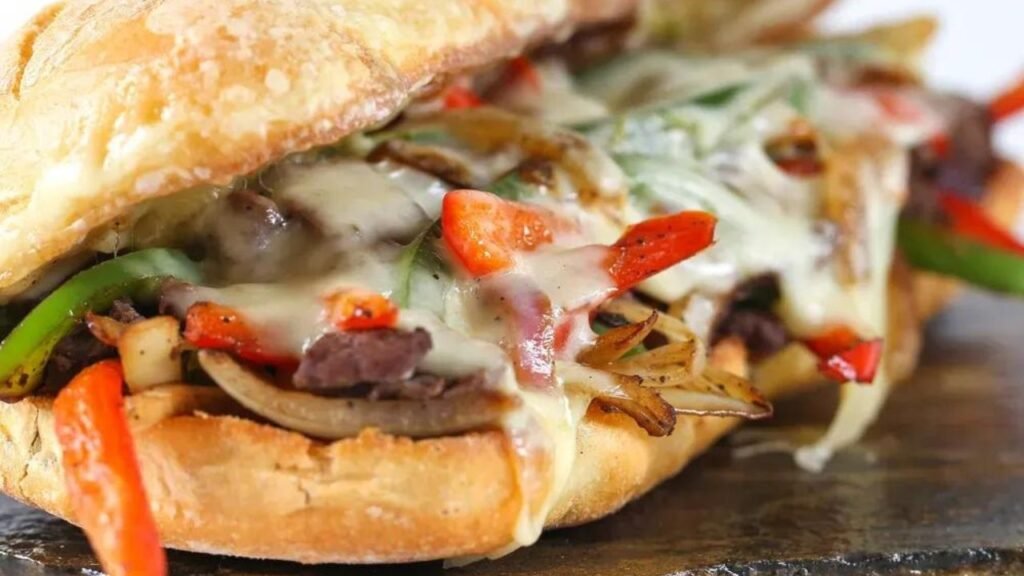The Philly cheesesteak is emblem of American comfort cuisine and a symbol of Philadelphia’s rich gastronomic legacy, not only a sandwich. Renowned for its soft rolls, melted cheese, and flavorful beef, this popular meal has become well-known all around and is still a favorite among foodies. The origins, defining qualities, and finest techniques for creating a real Philly cheesesteak are investigated in this page.
Background and Origins
Philadelphia, Pennsylvania’s 1930s saw the beginnings of the Philly cheesesteak. Pat and Harry Olivieri, proprietors of a South Philadelphia hot dog stand, are credited with creating the sandwich. Legend holds that Pat Olivieri chose to make something fresh by cooking some beef, adding onions, and rolling it. Local taxi drivers delighted by the sandwich so much that Pat and Harry decided to make it their main product.
Originally, the idea was only thinly sliced beefsteak grilled on a griddle topped with sautéed onions and presented on a hoagie sandwich. With Cheez Whiz, provolone, and American cheese among the most often used ingredients, cheese became a trademark of the sandwich throughout time. Established by Pat Olivieri, Pat’s King of Steaks is still open today and among the most well-known places offering this classic sandwich.
Clarifying Features

The Philly cheesesteak is distinguished for a number of important traits:
Usually sirloin or ribeye, thinly sliced beef is fried on a griddle. The beef should have a juiced texture and be tender and nicely seasoned.
Cheese: Traditionally available alternatives include cheez whiz, provolone, or American cheese; this is a vital ingredient. Melted over the steak, the cheese forms a creamy, savory toping.
Serving the sandwich on a long, soft hoagie bun or sub roll, Hoagie bun Usually having a rather crisp outside, the roll should be strong enough to contain the contents without turning soggy.
Traditionally used as a topping, sautéed onions bring taste and sweetness. Bell peppers, mushrooms, and pickles are other optional toppings.
Classic Philly Cheesesteak Recipe
Use this recipe to create a real Philly cheesesteak right at your house:
Food components:
One pound sirloin steak or ribeye cut thinly.
One spoonful olive oil
One big onion, thinly cut.
½ cup sliced bell peppers (optional)
One cup American cheese, provolone, or cheez whiz.
Four hoagie rolls.
Taste fresh ground black pepper in conjunction with salt.
One optional teaspoon garlic powder
One teaspoon, optional onion powder
Orders:
Get ready the beef by: Arrange the thinly sliced beef in a bowl and, if using, sprinkle onion powder, garlic powder, salt, and pepper. toss to coat.
In a large skillet or griddle set on medium heat, warm olive oil for the onions and peppers. About 8 to 10 minutes, sauté the sliced onions—and bell peppers, if using—until they are tender and caramelized. Take out of the skillet and set aside.
Cook the beef in the same skillet; if necessary, add a bit more oil. Add the seasoned beef slices and cook, medium-high, until browned and cooked through—about three to five minutes. To prevent crowding, you might cook the meat in stages on a griddle.
Combine beef with the caramelized onions (and peppers) back in the skillet. Stir until blended; heat through.
Divide the meat mixture in four sections in the skillet. Add cheese. Top each piece with cheese and cover for a minute or two to melt it.
Form the sandwiches by splitting the hoagie buns lengthwise but not all the way through to leave a hinge. Lay every bit of the cheese and meat mixture on the rolls.
Present the sandwiches hot; add optional condiments and sides of your preferred taste.
Variations & Modern Twists

Though the traditional Philly cheesesteak is great, there are several modifications and contemporary takes:
To make a cheesesteak hoagie, toss lettuce, tomato, and mayonnaise into the sandwich so mixing characteristics of a classic hoagie with the cheesesteak.
Top a French fries portion with chopped cheesesteak beef and melted cheese for a variation on the traditional.
For a variation on the traditional sandwich, substitute thinly sliced chicken breast or thighs for the beef.
To make a vegetarian or vegan cheesesteak, use vegan cheese and a plant-based meat replacement.
To give the beef mixture a fiery kick, toss jalapeños or hot sauce into it.
Serving Ideas and Combining Notes
Though they are sometimes eaten on their alone, Philly cheesesteaks go well with a range of sides and drinks:
Classic sides could be a side salad, onion rings, or French fries. For more crunch, you may present the cheesesteak alongside pickles or coleslaw.
Drinks: Rich flavors of the cheesesteak go nicely with a lager or pale ale, a chilled beer. Try a chilled soda or iced tea as non-alcoholic choices.
Add more taste with fresh herbs like parsley or basil, sautéed mushrooms, or spicy sauce.
Popularity and Cultural Effect
Considered a classic American sandwich, the Philly cheesesteak is eaten all throughout the nation and beyond. Its success has resulted in many variants and adaptations demonstrating its adaptability and appeal.
Celebrated yearly on National Cheesesteak Day, Philly cheesesteaks also feature food festivals, gastronomic contests, and food presentations. Popular culinary culture, food trucks, and menus of restaurants all clearly show the continuing appeal of the sandwich.
The Philly cheesesteak is a symbol of American comfort food and a slice of Philadelphia’s culinary legacy, not only a sandwich. This classic sandwich still enthralls taste receptors and meets needs with its soft bun, melted cheese, and juicy beef. Whether savored in its traditional form or with contemporary variations, the Philly cheesesteak is a timeless favorite honoring the art of simple, good cooking.